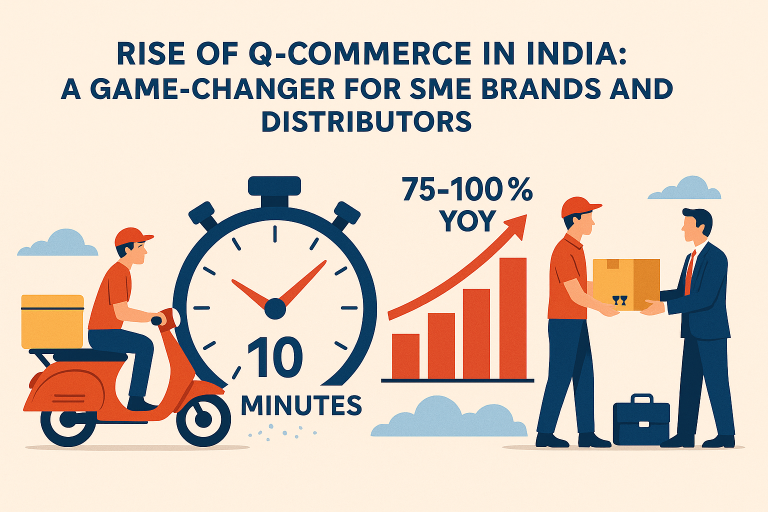Customer segmentation in the B2B sector is markedly different from segmentation in the B2C sector. While B2C segmentation focuses on direct-to-consumer sales and individual preferences, B2B segmentation deals with businesses as customers. This guide will delve into the intricacies of B2B customer segmentation, highlighting its unique features, benefits, and practical applications.
B2B is natural way to grow for any business. While B2C may be the first step – eventually all business has to descend from virtual to real world, i.e. offline. Omnichannel, a blend of B2C and B2B – is the ideal way to scale up business.
Understanding B2B Transactions
In B2B transactions, both the buyer and seller are businesses. Unlike B2C, where products are sold directly to consumers, B2B sales involve selling to intermediaries or other businesses. These transactions often occur in large volumes, and prices fluctuate based on the order quantity. Here are some key characteristics of B2B transactions:
- Bulk Sales: B2B sales typically involve large quantities, which means fewer customers but larger orders compared to B2C.
- Price Variability: Prices in B2B transactions are not fixed; they vary with the volume of the order. The higher the quantity, the lower the price per unit.
- Regular Purchases: Business buyers tend to place regular orders, making repeat business a critical aspect of B2B sales.
- Negotiation: Bargaining is a common feature in B2B transactions, necessitating strong negotiation skills.
- Credit Terms: Credit is often an integral part of B2B sales, with terms and conditions tailored to the buyer’s creditworthiness.
- Joint Responsibility for After-Sale Service: Both the buyer and seller share the responsibility for after-sale services, ensuring customer satisfaction and long-term relationships.
- Quality Over Quantity: The quality of customers is more important than the sheer number, as each customer represents significant revenue.
- Logistics: Given the large volumes involved, logistics and supply chain management play a crucial role in B2B transactions.
Segmentation in B2B: Factors to Consider
Effective B2B segmentation requires understanding the unique needs and behaviors of business customers. Here are some factors to consider:
- Industry: Segmenting by industry allows you to tailor your offerings to meet specific industry needs. For example, a software company might segment its customers into finance, healthcare, and manufacturing sectors, each with distinct requirements.
- Company Size: The size of a business can influence its purchasing behavior. Small businesses may look for cost-effective solutions, while large enterprises might prioritize scalability and support.
- Geographic Location: Geographic segmentation helps in understanding regional market dynamics and addressing location-specific needs, such as local regulations and cultural preferences.
- Purchase Behavior: Analyzing purchase patterns, such as frequency and volume of orders, helps in identifying key customer segments. This can include high-volume buyers, occasional buyers, and new customers.
- Customer Needs: Understanding the specific needs and pain points of different customer segments allows for more targeted marketing and product development.
- Decision-Making Process: Different businesses have varying decision-making processes. Some might involve a single decision-maker, while others require consensus from multiple stakeholders.
Practical Applications of B2B Segmentation
- Targeted Marketing Campaigns: Segmentation allows for more personalized marketing efforts. For example, a company selling industrial machinery can create targeted campaigns for different sectors like automotive, aerospace, and electronics, highlighting industry-specific benefits.
- Customized Solutions: By understanding the unique needs of each segment, businesses can offer customized solutions that address specific pain points. This enhances customer satisfaction and loyalty.
- Improved Sales Strategies: Sales teams can prioritize leads based on segmentation, focusing their efforts on high-potential customers. This increases efficiency and conversion rates.
- Optimized Product Development: Segmentation insights help in developing products that meet the specific needs of different customer groups, ensuring better market fit and higher acceptance rates.
- Enhanced Customer Support: Tailored after-sale services can be provided based on customer segments, ensuring better support and fostering long-term relationships.
Examples of B2B Segmentation
Example 1: A Chemical Supplier
A chemical supplier might segment its market as follows:
- Industry: Pharmaceuticals, agriculture, automotive, textiles.
- Company Size: Small laboratories, medium-sized manufacturing units, large multinational corporations.
- Geographic Location: Domestic markets, international markets (Asia, Europe, North America).
- Purchase Behavior: High-volume buyers, medium-volume buyers, low-volume buyers.
- Customer Needs: High purity chemicals, cost-effective solutions, customized formulations.
Example 2: A Software Development Company
A software development company might use the following segmentation:
- Industry: Healthcare, finance, education, retail.
- Company Size: Startups, SMEs, large enterprises.
- Geographic Location: Urban areas, rural areas, international markets.
- Purchase Behavior: Subscription-based clients, one-time purchase clients.
- Customer Needs: Data security, user-friendly interface, integration with existing systems.
Benefits of B2B Segmentation
- Increased Efficiency: By focusing on specific segments, businesses can allocate resources more effectively, resulting in higher efficiency and productivity.
- Better Customer Understanding: Segmentation provides deeper insights into customer needs and behaviors, enabling businesses to better understand and serve their customers.
- Higher Customer Satisfaction: Tailored marketing and customized solutions lead to higher customer satisfaction and loyalty.
- Competitive Advantage: Businesses that effectively segment their markets can gain a competitive edge by addressing the unique needs of different customer groups.
- Improved Profitability: Targeted marketing and sales efforts lead to higher conversion rates and increased profitability.
Challenges in B2B Segmentation
While B2B segmentation offers numerous benefits, it also presents some challenges:
- Data Collection and Analysis: Gathering and analyzing data for segmentation can be complex and time-consuming. Businesses need robust data collection and analysis tools to ensure accurate segmentation.
- Dynamic Markets: B2B markets are dynamic, with customer needs and behaviors constantly evolving. Businesses must continuously monitor and update their segmentation strategies to stay relevant.
- Integration Across Departments: Effective segmentation requires integration across various departments, including marketing, sales, and customer support. Ensuring seamless coordination can be challenging.
- Customization vs. Standardization: Balancing the need for customized solutions with the benefits of standardized offerings can be difficult. Businesses must find the right balance to meet customer needs while maintaining operational efficiency.
Conclusion
Customer segmentation in the B2B sector is essential for understanding and addressing the unique needs of business customers. By considering factors such as industry, company size, geographic location, purchase behavior, customer needs, and decision-making processes, businesses can create targeted marketing campaigns, customized solutions, and optimized sales strategies.
Despite the challenges, effective B2B segmentation leads to increased efficiency, better customer understanding, higher satisfaction, competitive advantage, and improved profitability. By leveraging segmentation insights, businesses can build stronger relationships with their customers and achieve sustainable growth. Here’s more information on b2b players in India – distributors, dealers, wholesalers, sales agents, super stockists, C&F agents.
For businesses transitioning from B2C to B2B, understanding these segmentation principles is crucial. By applying these strategies, you can navigate the complexities of the B2B market and unlock new opportunities for growth and success.

